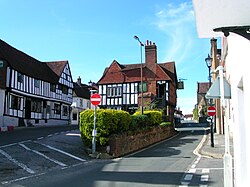Midhurst
| Midhurst | |
| Sussex | |
|---|---|
 Midhurst from the south | |
| Location | |
| Grid reference: | SU885214 |
| Location: | 50°59’6"N, -0°44’24"W |
| Data | |
| Population: | 4,889 (2001) |
| Post town: | Midhurst |
| Postcode: | GU29 |
| Dialling code: | 01730 |
| Local Government | |
| Council: | Chichester |
| Parliamentary constituency: |
Chichester |
| Website: | http://www.midhurst-tc.gov.uk/ |
Midhurst is a market town in north-western Sussex. It stands on the River Rother
Midhurst has been a prosperous town for many centuries. The ruin of a Tudor mansion, Cowdray House, is here and the stately Victorian Cowdray Park is here. Parts of the Spread Eagle Hotel date back to 1430; the hotel was formerly a coaching inn.
Country Life magazine rated Midhurst the second-best town in Britain, beaten only by Alnwick.[1]
At the 2001 Census 2001 parish was recorded as having 2,327 households with a total population of 4,889. In 1831 the population was 1,478; the town has resisted the uncontrolled expansion seen elsewhere.
Each year the town hosts the Veuve Clicquot Gold Cup which is a major polo competition. This is held on the estate of Lord Cowdray, with the final played outside the ruins. Prince Charles and other members of the royal family are often seen there.
Churches
Parish church
Formerly standing within the grounds of Midhurst Castle, the parish church of St Mary Magdalene and St Denys was mentioned in 1291 and later in 1367 as standing, "in a place called Courtgene". It now stands in the market square.
The base of the tower is 13th century. Otherwise the church was largely rebuilt in the Perpendicular style in 1422, towards the end of Henry V's reign. The tower top, south nave and chancel arcades are 16th century in the perpendicular]] style. The rest of the building is from a restoration in 1882 or later.[2][3]
Other churches
- Church of England: St Mary and St Denys
- Methodist: Midhurst Methodist Church. A large Gothic style west window looks towards the ruins of Cowdray House.
- Roman Catholic: The Divine Motherhood and St Francis of Assisi
History

It would appear that Midhurst castle was dismantled by the Bishop of Durham at some time between 1284 and 1311. The earlier owners had been the de Bohun family who abandoned the castle in favour of Cowdray in 1280.
In 1605 the owner of Cowdray House, Anthony-Maria Browne, 2nd Viscount Montagu, was briefly arrested in connection with the Gunpowder Plot. He was suspected as a plotter because he briefly employed Guy Fawkes as a footman and stayed away from Parliament on 5 November following a warning from Robert Catesby. He is buried in Midhurst Church.
Midhurst was once linked by three rail lines, from Pulborough (1866), from Petersfield (1864) and from Chichester (1881); the latter closed in 1935 to passengers and in 1951 to goods traffic. There were formerly two stations too.
The author H G Wells lived in Midhurst during the 1880s. He worked briefly as an apprentice at a chemist and a few years later he joined the Midhurst Grammar School where he was both a pupil and an assistant teacher.[4]
Sport and leisure
Midhurst has a Non-League football club Midhurst & Easebourne F.C. who play at Dodsley Road.
Transport

Outside links
| ("Wikimedia Commons" has material about Midhurst) |
References
- ↑ Country Life Magazine article
- ↑ Nairn, Ian; Pevsner, Nikolaus (1965). The Buildings of England: Sussex. Harmondsworth: Penguin Books. p. 271. ISBN 0-14-071028-0.
- ↑ "History and Architecture". Midhurst Parish Church. http://www.midhurstparishchurch.net/index_files/History.htm. Retrieved 20 April 2012.
- ↑ Visit Midhurst website
